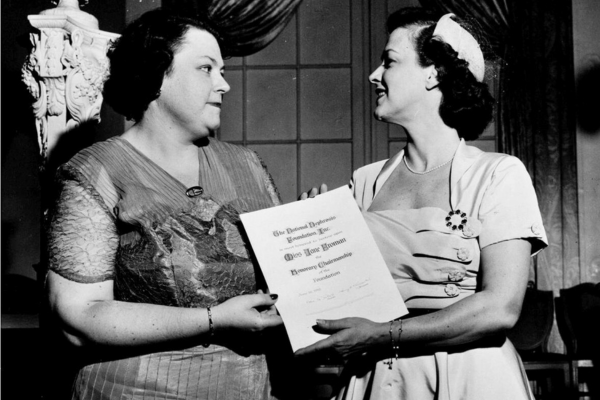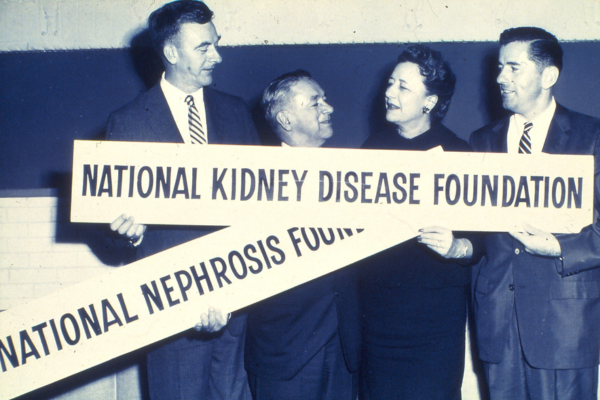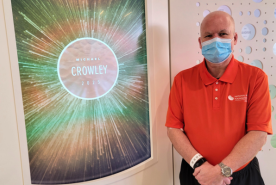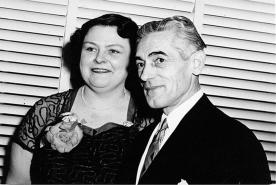February 06, 2025
NKF Officers with signs depicting the name change, and focus, of the Foundation, when The National Nephrosis Foundation became The National Kidney Disease Foundation.
In 1950, Ada and Harry DeBold learned that their infant son had kidney damage from nephrotic syndrome. Today, treatments like dialysis or kidney transplants would give him a chance at life. Back then, these treatments weren’t available.
The DeBolds didn’t give up. Their determination led to the creation of the National Kidney Foundation (NKF). 75 years later, NKF continues to revolutionize the fight against kidney disease.
How did we get here? Keep reading to find out.
Kidney Disease Treatments Through the Centuries
Kidney disease and kidney failure have existed as long as humans. Before the 1600s, medical knowledge was basic. Few records about kidney health were kept. Even so, researchers found evidence of kidney disease referenced in ancient Rome and China.
In 100 A.D., Roman citizens struggling with high urea levels soaked in public baths to “sweat out” the toxins. Urea is a toxin that healthy kidneys remove. High levels can cause exhaustion, weakness, nausea, and confusion. In 200 A.D., China’s first surgeon, Hua Tuo, reportedly replaced failing organs with healthy ones.
Throughout history, people have worked to treat kidney problems using the knowledge and tools available to them.
Timeline of Kidney Disease Research and Treatments:
- 1668: Job van Meekeren, a Dutch surgeon, recorded the first known successful bone transplant. A bone from a dog was used to patch a human skull. This discovery paved the way for the future of transplantation.
- 1827: English Doctor Richard Bright began researching kidney issues. Today, Bright is called the “Father of Nephrology”.
- 1861: Scottish chemist Thomas Graham was the first to develop the concept of dialysis. His theory and prototype laid the groundwork for the future dialysis machine.
- 1913: Drs. John Abel, Leonard Rowntree, and Benjamin Tuner developed the first practical dialysis machine. It was a large device made from glass tubes used for animal experiments.
- 1924: German doctor George Hass performed the first human hemodialysis treatment.
- 1933: Experts found that the 1586 King of Poland died from polycystic kidney disease (PKD). PKD causes cysts to grow in the kidneys.
- 1934: French surgeon Alexis Carrel found a way to prevent organs from dying outside the body.
- 1944: Dr. Willem J. Kolff invented the first practical hemodialysis machine. He used sausage casing, wooden drums, and washing machines. He is remembered as the modern “Father of Dialysis."
- 1945: Holland patient was successfully treated for acute kidney failure with dialysis.
- 1948: Mount Sinai Hospital performed the first dialysis procedure in the US.
- 1948: Edward Olson redesigned the dialysis machine to treat Korean War soldiers with acute kidney failure.
DOUBLE your impact today.
- Equip patients and families with knowledge, resources, and access to high-quality care.
- Advocate for policies that address disparities and prioritize kidney health for all.
- Fund research and technology to advance early detection, improve treatment, and expand transplant access.
NKF Is Born

Ada DeBold (L) presenting Miss Jane Hroman (R) with an honorary chair award.
Despite the prognosis, the DeBolds weren't ready to accept defeat. In November 1950, they held an event to raise money to find a cure. The National Nephrosis Foundation was born.
The Debolds' son passed away at four years old. Despite the heartbreak, the DeBolds' resolve to find new treatments didn’t waver. They continued spreading the word about childhood kidney disease.
As the National Nephrosis Foundation found its footing, kidney disease research continued.
Timeline of Kidney Disease Research in the 1950s:
- 1955: Drs. Watschinger and Willem Kolff created the first practical dialysis machine.
- 1956: Dialysis was available but not widely used due to cost and difficulty using the machine.
- 1958: The Committee for Nephrosis Research was renamed the National Kidney Disease Foundation. The focus moved from childhood nephrosis to all kidney disorders.
As the end of the decade grew closer, the situation for people with kidney disease remained dire. Patients had few options to slow down the disease and treatments were limited.
Subscribe today!
Join the NKF Blog Newsletter
Get inspirational stories and kidney disease resources delivered to your inbox every month. You'll gain practical insights and expert advice to help you better understand and manage your kidney health no matter where you are on your kidney journey.


















